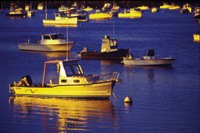Image Stabilizers And Anti-Shake Systems
Do They Do The Job, And Are They Worth The Premium Price?
Regardless of the type of
equipment that we use, image blur caused by hand and body motion is
one of the principal causes of unsatisfactory photos. It's especially
difficult to make razor-sharp images when shooting with a handheld camera
in low light and when using long lenses that magnify the least camera
shake. Although most advanced photographers use a tripod when possible,
a handheld camera allows for greater mobility. Of course, there area
also situations where carrying a tripod is less than practical, during
cycling or backpacking trips, for instance. Finally, a tripod is useless
when shooting from watercraft or aircraft because the accessory transmits
movement to the camera. |
||||
Tripod Alternatives |
||||
Optical And Other Stabilizers |
||||
Panning Allowance |
||||
Stabilizer System Evaluation |
||||
Two Or Three Stop Gain Peter K. Burian, a free-lancer
stock photographer and long-time "Shutterbug" and eDigitalPHOTO" contributor,
is the author of a new book, "Mastering Digital Photography and
Imaging" (Sybex, March 2004). Covering all aspects of the topic--the
technology, equipment, and techniques--this book provides 300 pages
of practical advice for photo enthusiasts. |
- Log in or register to post comments








































